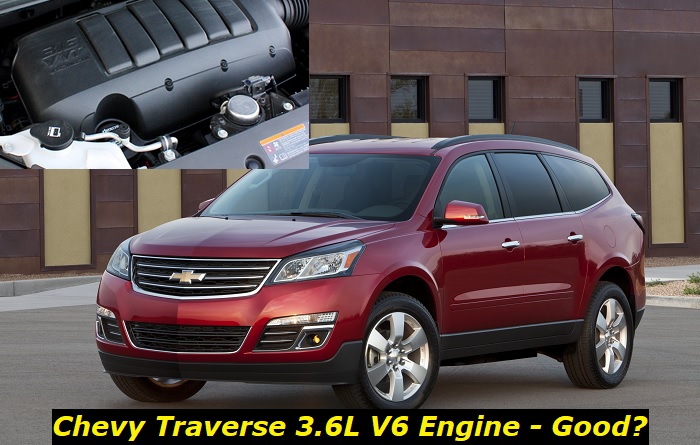The Chevrolet Traverse was launched in 2009. It is a large three-row full-size SUV that boasts good ground clearance. The SUV was designed with large and growing families in mind, hence the third row. The car will accommodate 7-8 passengers with ease. Chevrolet equipped the first generation of the Chevrolet Traverse with a 3.6L V6 engine to power the large vehicle.
We take a look at the Chevrolet Traverse 3.6L V6 LLT engine and explore the likely problems that are commonly reported to affect it. We will also take a keener look at the engine's longevity and hence the SUV's reliability and the engine's specs.

Key features and my opinion about the engine
- Production years:2007-2017
- Average lifespan of LLT:180,000-210,000 miles
- Fuel supply type:direct injection
- Power range:280-315 hp
- Fuel efficiency:bad
- Engine block material:aluminum
- Engine reliability score:medium
- The most common problems:weak timing chain, complicated injection system, carbon buildup on intake valves, water pump problems.
The 2009-2018 Chevrolet Traverse 3.6L V6 engine
Production of the Chevrolet Traverse commenced in 2008, and the engine fitted in the first generation of this model is a 3.6L LLT V6. The engine has an actual displacement of 3,564cc and is a direct-injected version of the earlier LY7 engine. The engine is complemented with a 6-speed hydra-Matic 6T75 automatic transmission for optimal performance.
From 2009 to 2017, Chevrolet equipped Traverse with either a single or a dual-exhaust engine. The single exhaust engine gave 281 hp power and 266 lb-ft Torque, while the dual exhaust boasts 288 hp power and 270 in Torque. In 2018, Chevrolet tweaked the 3.6L V6 LLT engine so that it could give 310 hp or 231 kW, and the transmission changed to 9-speed. From 2018, the SUV comes with a dual exhaust system.
The 2009-2018 Chevrolet Traverse specs
- The actual displacement or size is 3,564 cm3 or 217.49 cu.in
- The Traverse 3.6L V6 engine has an output power of 281 Hp
- It is a petrol engine
- It translates 78.8 Hp/liter, and the engine reaches a maximum speed of 6,950 RPM.
- The Torque is 266 lb-ft.
- It is an internal combustion engine and drives the vehicle's front wheels.
- The engine has 6 cylinders that are positioned in a V pattern
- There are 4 valves per cylinder
- The cylinder bore is 3.7 inches, and the piston stroke is 3.37 inches or 85.6 mm.
- The engine is naturally aspirated and uses direct injection for its fuel system.
- The engine oil capacity is 5.2 liters, while the coolant is 11.2 liters.
- It allows the 2018 Chevrolet Traverse to accelerate from 0-60 mph in 7.2 seconds.
What common problems affect the 2009-2018 Chevrolet Traverse 3.6L V6 engine?
- Sudden loss of power, then engine stalling.
The older Chevy Traverse has had a lot of drivers report the engine suddenly losing power. This problem can occur without any warning by engine stalling. In many instances, those affected report noticing the dashboard lights dimming, accompanied by a loss of power. The lights will brighten suddenly and then dim, and this continues intermittently.
The warning sign that comes on the dashboard is the 'Service Stabilitrak.' You will also notice the engine will stutter. Some drivers report seeing the check engine light (CEL) after the vehicle has lost power or stalled.
Solution:
It becomes a serious issue when your Chevy suddenly losses power when you are on the highway. It is even scarier and more dangerous when it stalls. After stalling, some drivers in online forums say that the engine will start after cooling off for about 20 minutes. The SUV, when it losses power, will give you a max speed of between 20 and 25 mph.
When connected to the OBD machine, there are all error codes, including P216A, P0606, P0014, P0302, and U0198. Drivers have replaced many parts, such as the Accelerator pedal sensor, Throttle body, Canister Purge valve, and even doing a fuel injection service with no or little success. Though this problem looks to have affected many Traverse owners, Chevrolet has not issued a recall but seems to have upgraded the engine over the years. The 2018 Traverse 3.6L V6 engine is less likely to give you these issues.
- Spark Plug malfunction
Chevy Traverse owners have also complained of engine misfiring in their SUVs. The engine can misfire when the car is idle or while driving. The main symptom is the check engine light and the misfiring. Sometimes, the check engine light will go away on its own, and many drivers will ignore it and think the problem has resolved itself.
When you take your car to an authorized Chevy dealer or use an OBD machine to determine why the check engine is lighting up and why the misfire, a P0300 error code is likely to pop up. Such a code means a cylinder is misfiring, and even though the CEL can go away on its own, the OBD can give you a history of the misfires. In some cases, such misfires run into hundreds.
Solution:
In most cases, it has been found that the spark plugs are the issue. Replacing the affected spark plug should solve this problem. But to get the best fuel efficiency and avoid this problem altogether, it is advisable to replace the whole set of spark plugs.
Though there are many genuine online shops, it has been reported by a good number of Traverse owners who have had to deal with this issue that they had bought the plugs from an online shop.
- Engine vacuum leak
Some 2009-2018 Chevrolet Traverse owners say their SUVs gave a check engine light. This light can be accompanied by an engine hesitation and then stalling. The engine further has high and sporadic idling, which is best detected through the tachometer.
A vacuum leak will make the car idle at very high RPMs and suddenly drop to extremely low RPMs. This is because a vacuum leak has added some air into the engine, which makes the engine spurt, hence an increase in RPM. Whenever air is introduced into the engine, the RPMs will rise suddenly before dropping. The symptoms are more or less similar to the spark plug failure since there is also misfiring, hesitation and stalling.
Listening to your engine, you can detect a vacuum leak in your Traverse. You will hear a hissing sound, especially if the leaks are not severe. A good number of Traverse owners have been affected by this problem. You can also diagnose this problem if you check live data from your 3.6L V6 engine.
Solution:
There are various methods that a mechanic can use to detect an engine vacuum leak. They can use a mechanic's stethoscope, bubble, propane, or water test. Repair time and cost vary widely depending on where the leak is happening. If it is the hoses that are leaking or the O-rings, then this can easily be handled. If the leak is at the intake manifold, then Chevrolet expertise will be needed and it will mean you will dig deeper into your pockets if the warranty isn't covering.
- High oil consumption
Owners of the Chevrolet Traverse, especially the older version, have complained about how their SUVs consume a lot of oil. This problem is usually caused by valve seal, PCV valve failure, or piston rings failure. Some of the symptoms to look out for include, low oil levels, blue exhaust smoke, oil on the spark plugs, and the smell of burning oil.
Solution:
How to correct this issue depends on the cause and what is broken. The repair works can be quite involving, especially if the issue is a malfunctioning piston. But once the oil issue is solved, most 2009-2018 Traverse owners don't report the recurrence of it.
How long does the 2009-2018 Chevrolet Traverse 3.6L V6 LLT engine last?
The Chevy Traverse is an iconic SUV that is well known for the solid and comfy drive it provides you with. It scores highly regarding how long it can serve you, causing you heartaches and problems. The SUV will give you 13 years, which translates to 200,000 miles. These estimates are mainly based on the assumption that one drives around 15,000 miles per year.
The first-generation Chevrolet Traverse scores moderately high when put side by side with other vehicles in its category. It beats Ford Explorer but scores lower than the Toyota Highlander. However, some issues that make the Traverse not last as long include the heavy corrosion of the exhaust pipes.
The driver's driving style determines to a great extent how long the vehicle will last. There is also the fact that a car well maintained even on the interior tends to last longer than a car that is taken to the car wash once every two months. The oil change and engine service will help you enjoy your Traverse for more than the stated 13 years.
Conclusion
The 2009-2018 Chevrolet Traverse 3.6L V6 engine is one of the best full-size SUVs in the market with the third row. The 3.6L V6 engine started with some teething problems, but it seems Chevrolet learned as the years went by and they upgraded the engine. The second generation of the SUV, which was introduced in 2018, seems to be fine, with the problems affecting the first generation being solved.
About the authors
The CarAraC research team is composed of seasoned auto mechanics and automotive industry professionals, including individuals with advanced degrees and certifications in their field. Our team members boast prestigious credentials, reflecting their extensive knowledge and skills. These qualifications include: IMI: Institute of the Motor Industry, ASE-Certified Master Automobile Technicians; Coventry University, Graduate of MA in Automotive Journalism; Politecnico di Torino, Italy, MS Automotive Engineering; Ss. Cyril and Methodius University in Skopje, Mechanical University in Skopje; TOC Automotive College; DHA Suffa University, Department of Mechanical Engineering






Add comment